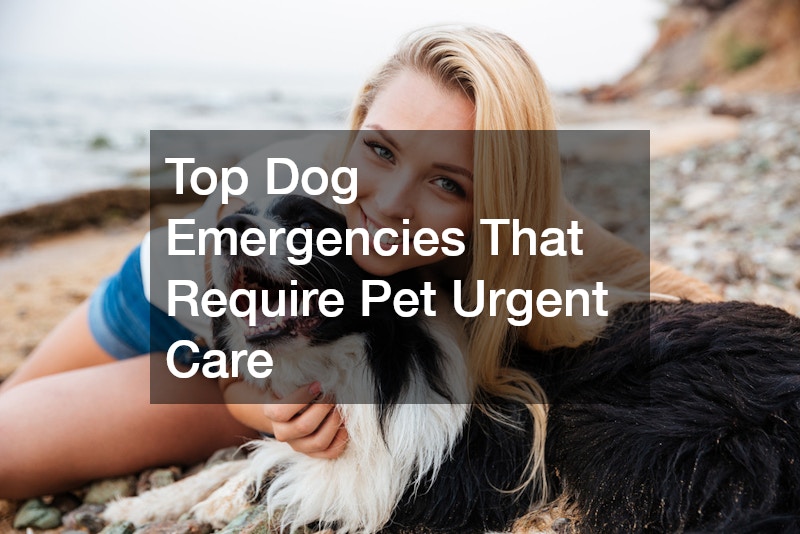
Our canine companions bring joy and love into our lives, becoming cherished family members. However, just like with human family members, emergencies can arise, and knowing when to seek pet urgent care can make all the difference. In this article, we will explore the top dog emergencies that often require swift medical attention to ensure your furry friend gets the care they need.
Toxic Substances
Dogs are curious creatures, often exploring their world through their mouths. This curiosity can lead them to ingest toxic substances such as chocolate, grapes, or household chemicals. Unfortunately, these substances can cause severe reactions in dogs, including vomiting, diarrhea, and even seizures.
If you suspect your dog has ingested something toxic, it’s crucial to act quickly. Contacting your veterinarian or a pet poison helpline can provide guidance on immediate steps to take. Subsequently, a visit to a pet urgent care facility may be necessary to stabilize your pet’s condition and provide necessary treatments such as activated charcoal or IV fluids.
Timing is critical during poisonings, so swift action can mean the difference between a full recovery and long-term health issues. Many pet owners are surprised at how common household items pose a threat to their pets. Knowing what items are toxic and recognizing symptoms quickly is essential for every dog owner.
Physical Trauma and Injuries
Accidents happen, and sometimes our pets are the unfortunate victims of physical trauma. Whether it’s a car accident, a fall from a height, or a dogfight, injuries can be severe and require immediate attention. Pet urgent care facilities are equipped to handle various traumas, providing essential services that can save your pet’s life.
Visible injuries like open wounds or fractures are clear indicators that emergency care is necessary. However, internal injuries may not be immediately apparent, making it vital to seek professional evaluation if your pet has been involved in an accident. Veterinarians can perform diagnostic tests such as X-rays or ultrasounds to assess the extent of injuries and determine the best course of action.
Immediate post-trauma care often involves stabilizing your pet while pain management and treatment plans are developed. The goal is to minimize complications and ensure your pet’s path to recovery is as smooth as possible. Regular check-ups post-injury can further aid in a full and speedy recovery.
Severe Allergic Reactions
Just like humans, dogs can experience allergic reactions that range from mild to life-threatening. Bee stings, certain foods, or medication reactions can trigger severe responses such as anaphylactic shock. Recognizing the signs, which may include swelling, hives, or difficulty breathing, is crucial.
Immediate intervention is necessary when a dog is experiencing a severe allergic reaction. Pet urgent care facilities can administer antihistamines, corticosteroids, or epinephrine as needed to counteract the reaction. Quick treatment can prevent further complications and provide relief to your pet in a stressful situation.
Monitoring your pet closely after an allergic episode is important, as delayed reactions can occur. Identifying the allergen responsible is also key, allowing you to avoid future incidents. Collaboration with your veterinarian can help in formulating a plan to manage and prevent further allergic reactions in your dog.
Heatstroke
Heatstroke is a serious risk for dogs, particularly during warmer months or in hot climates. Unlike humans, dogs cannot sweat to cool down effectively, making them more susceptible to overheating. Signs of heatstroke include excessive panting, drooling, and weakness.
If you suspect your dog is suffering from heatstroke, it’s crucial to move them to a cooler environment immediately and provide access to water. Applying cold, damp towels to their body can help lower their temperature. Even with these measures, visiting a pet urgent care facility is essential, as professional medical intervention could become necessary to address dehydration or organ damage.
Preventing heatstroke involves ensuring your dog gets plenty of shade and water, especially during hot days, and avoiding rigorous activities. Understanding your dog’s limits and being vigilant during high-temperature periods can help keep them safe. Continuous education about temperature awareness can greatly reduce the incidents of heat-related emergencies.
In emergencies, knowing when to seek pet urgent care for your dog can be lifesaving. From toxic ingestions and physical trauma to allergic reactions and heatstroke, these situations demand swift action. By recognizing the signs and acting promptly, you can ensure your dog receives the care they need to recover fully and continue brightening your days.
Owning a dog is a rewarding experience, but it comes with responsibilities, including being prepared for potential emergencies. By familiarizing yourself with the top dog emergencies requiring urgent care, you are taking a proactive step in safeguarding your pet’s health. With this knowledge, you are better equipped to act quickly, ensuring your beloved pet stays happy and healthy for years to come.

